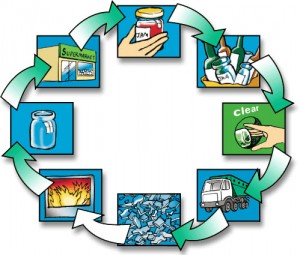
Ever wonder what happens to recyclables after being collected by the city’s recycling service? The city of Raleigh’s curbside recycling service collects items such as aluminum; glass; plastics #1-5 and #7; newspapers; magazines; telephone books; white, colored and shredded paper; corrugated cardboard; paperboard, chipboard and spiral paper cans (such as Pringles cans). Single-stream recycling is the method of recycling implemented in North Carolina: All recyclables may be tossed in one recycling bin. North Carolina has banned aluminum cans and plastic bottles from disposal in landfills, and therefore these are required to be recycled by law.
Products can go one of two routes, being “down-cycled” or “up-cycled.” In down-cycling, recycled products are weaker than original products. Paper can no longer be used after going through the recycling process several times. In up-cycling, the recycled products are stronger than the original products, such as when artists create furniture out of aluminum cans, etc. However, it is not often that a recycled product becomes the same as the original product.
First, recyclables are brought to a recycling center. Many people believe that recycling is only trucked straight to the landfill. In fact, recyclables are considered commodities due to their monetary value. On the other hand, waste does not possess financial value. It often costs money for waste companies to dump their waste in landfills, and so it would not be financially logical for recycling companies to simply throw the recycling away. Recycling also helps communities save money by keeping materials out of landfills and directing them towards manufacturers who will pay for them.
Second, the recycling is sorted at the center. Many non-recyclable items such as pizza boxes and PVC pipes must be discarded due to the uncleanliness and amounts of additives that would cause impurities in new, recycled materials. This discarded material is termed “residual.” The less residual, the more profit for the recycling company.
The recycling is brought via conveyor belt to a machine called a V-Screen separator. The rotators in the V-Screen separate paper items from plastic, glass and metal items. The paper is bundled and prepared for recycling, while the metals, glass and plastics fall through to another conveyor belt which transfer them to a 2-step metal recovery system.
Ferrous metals (such as iron and steel) are removed by powerful magnets from the rest of the items and moved to an area where they can be processed. Aluminum is not magnetic and therefore must be transferred by an eddy current, which creates a strong field of energy around the aluminum and separates it for processing.
Then, an optical scanning system recognizes plastics and removes them with blasts of air. The glass items are now the only materials that remain at the end of the process. This entire manner of sorting requires little human interaction.
Papers are moved to a paper mill, which washes them with chemicals that removes the ink, reduces them to pulp, washes the pulp to extract contaminants, and then presses the clean pulp. It is rolled and flattened into new paper.
Metal is also sent to a mill where it is turned into a molten liquid, which is cast in molds that create metal bars. Once these bars are cooled, they are sent to metal manufacturers who create new products from the raw metal.
Plastics are separated by their numbers (1-7) at a reclaimer. PET, plastic #1, is the most common type of plastic. This plastic is turned into flakes which are melted into a polymer mixture and used to create new plastics.
In glass processing, the glass is smashed into small pieces (“cullet”). Manufacturers can either mix this cullet with virgin materials or melt it down to produce recycled glass products.
Other items, like batteries, are also important to recycle. Lithium ion batteries are one of the few items that can be 100% recycled. The batteries are often split up into different components (such as lead acid batteries being separated into plastic, lead and sulfuric acid) and these individual components are recycled.
Overall, recycling is an extremely easy way for consumers to help the environment and save their communities money. This process keeps millions of pounds of post-consumer products out of landfills and puts them to use once again.
Leesville Road High School already works to help the environment by maintaining an environmental club and a recycling program. Additionally, students should strive to resist the urge to throw bottles and cans on the ground of the student parking lot or into waste bins, and instead find a recycling bin to dispose of the materials.
Faculty should work to make recycling bins more accessible, such as in the parking lot and in the cafeteria. Leesville Road High School can easily contribute to protecting the community and the environment by realizing the importance of recycling and acting on it accordingly.
Leave a Reply